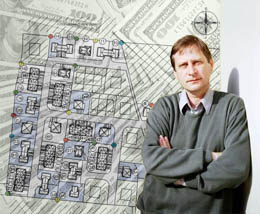
The alternative to suburban settlements could be brownfields
 |
Former factories and, in the Czech Republic, even former military areas have a significant advantage - they are often well connected to transportation networks; industrial sites are frequently located directly within cities. They thus offer a wide range of uses. However, their problems often include ecological burdens or property rights issues arising from privatization. According to Maier, panel housing estates could also become brownfields if people abandon them and no new generation emerges that wants to live there.
Among the most famous European examples of such redevelopment are the Tate Modern gallery in London, which was created from a former power plant, and the transformation of century-old gas holders in Vienna into apartments and shops. In Prague, Holešovice, Vysočany, and Karlín are particularly appealing for brownfield investors, while in Zlín, a costly reconstruction of one of Baťa's buildings has created a seat for the regional office.
According to Maier, suburban settlements need an alternative - they have not brought people what they expected. "They are called horizontal housing estates; the improvement in quality of life compared to the panel houses is debatable," he stated. People have voluntarily chosen to move outside the city, buying a house with their own money, but there will come a time when there will be significant demands on the local infrastructure, which the homeowners may not be able to afford, the expert believes.
Whether the costs will be covered by investors or funded with public money, according to him, relates to the approach to city development planning. After 1989, there are various opinions on this - on one hand, the quality of the urban environment is seen as a commodity, and in that case, its spontaneous development is left to investors; on the other hand, urban development is viewed as a public interest; in that case, public administration should regulate urban development and support the regions that need it.
Maier and other experts agree that there is no level of self-governance in the Czech Republic that would address these issues effectively. Regions are too distant, and municipalities are not able to manage this; regional coordination is necessary, believes Maier.
However, suburban housing is just another stage in the evolution of historical cities. According to Maier, Czech cities generally consist of a historical core from which the city center was established at the turn of the 19th and 20th centuries, from the development that occurred during industrialization (blocks of apartment buildings and villa districts), and from housing estates from the socialist era, designed for all social classes. After 1989, the market entered city development, historical cores began to revive, and they also started to compete with suburban shopping centers, Maier noted.
However, according to him, the prosperity of the centers has led to "overheating," and they predominantly serve either tourist, office, or luxury housing functions - all of which transform the centers into "ghettos," whose emergence is in direct contradiction with the character of the cities and their original functions.
Another problem for historical cities, according to Maier, is the significant conflict between heritage conservation and investors. "Heritage conservation is based on the strict protection of physical elements, but it has neither the right nor the interest to dictate how historical objects should be used. From a church to a show museum - that has already happened," he remarked, referring to the criticized reconstruction and current use of the St. Michael's Church in Prague. "The question is, what is the value of the historical core; is it the cornices, or the way cities are utilized?" asks Maier.
The English translation is powered by AI tool. Switch to Czech to view the original text source.
1 comment
add comment
Subject
Author
Date
Ad Zlín
Ivan Kantorek
24.11.06 07:57
show all comments











